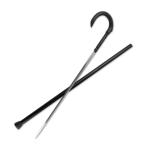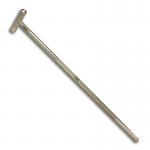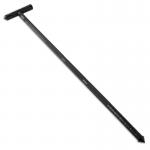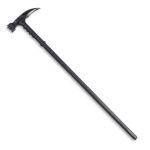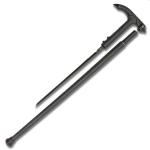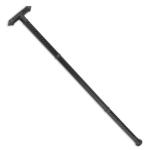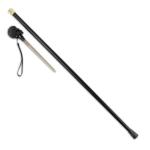The Sword Cane: A Legacy of Fashion, Self-Defense, and Legal Drama
May 19th, 2025

The sword cane, a walking stick that hides a blade inside it, might seem like something straight out of a spy novel or a period drama. But its origins go way back to real life, where the sword cane was not only a symbol of elegance but also a tool for self-defense. Throughout history, it has been both a fashionable accessory and a weapon of choice for those seeking to protect themselves. Yet, in modern times, it has also become a controversial object, subject to numerous laws and legal battles.
In this blog post, we'll take a look at the fascinating history of the sword cane, its rise as a fashion statement, the legal challenges it's faced, and how it still manages to intrigue people today.
The origins of the sword cane are shrouded in mystery, but it's believed that the idea of a concealed weapon dates back to at least the 17th century. Early examples were crafted by European and Asian artisans and were designed for self-defense. They were particularly popular among the aristocracy, who used them to protect themselves during a time when duels and street brawls were common, and personal safety was a constant concern.
But the sword cane wasn't just about fighting; it also became a statement of status and refinement. In the 18th and 19th centuries, particularly during the Victorian era, sword canes became a hallmark of sophistication. Think of it as the gentleman's equivalent of the pocket watch or top hat; practical but also an essential accessory for any man of culture. Cane makers would use high-quality materials like ivory, tortoiseshell, and fine woods, crafting canes that looked elegant but had a blade concealed inside.
The blade itself was often a thin, flexible sword or rapier, ideal for quick, defensive movements. For someone of the upper class, owning a finely made sword cane wasn't just about self-defense; it was about signaling wealth, style, and sophistication. The sword cane was as much about looking the part as it was about playing it safe.
While sword canes had an undeniable elegance, their primary function was much more practical. They were designed for self-defense, a tool of last resort in a world where street violence was more common and personal security wasn't always guaranteed. A gentleman might carry a sword cane as both a walking aid and a concealed weapon. It was a way to protect oneself without arousing suspicion. After all, who would think twice about a harmless-looking cane?
In an era when duels and personal combat were sometimes the only way to settle disputes, having a concealed weapon like a sword cane could be a lifesaver. However, sword canes weren't just carried by the rich. People in all walks of life could use them for protection, though the wealthy were certainly more likely to own high-end models with hidden blades.
As time passed, sword canes began to raise more than just eyebrows. They started to raise alarms. While they were once symbols of status and self-defense, the more people carried them, the more the law began to view them as a potential threat.
In the United States, sword canes (and other concealed weapons) started to attract attention from lawmakers who were concerned about public safety. Throughout the 20th century, cities and states began enacting laws that prohibited the carrying of concealed weapons, and the sword cane fell into this category. The issue? Concealed weapons made it easier for people to carry dangerous tools without being detected, which created a risk for violent confrontations.
Laws regulating concealed weapons varied from state to state. Some states had very strict laws regarding swords and knives, while others allowed a broader range of self-defense tools. However, in many places, the sword cane was outright banned or restricted due to its dual nature as both a weapon and a fashion accessory.
For example, in California, it became illegal to carry a sword cane in public without a special permit. Many cities across the U.S. followed suit, and in some cases, people were arrested or fined for carrying them. Interestingly, these laws often sparked debates over personal freedom and the right to carry a weapon for self-defense.
Over the years, sword canes have been involved in several high-profile lawsuits and legal controversies. Many of these cases revolve around whether or not carrying a sword cane should be considered a crime or a simple right of personal protection.
In one infamous case, a man in New York City was arrested in the 1990s for carrying a sword cane in public. The man argued that he needed the cane for mobility, but the authorities believed that he was using it as a concealed weapon. After a lengthy court battle, the case was dismissed, but not before the issue of concealed weapons was debated in the media and in legal circles.
Another high-profile case involved a man in California who had been carrying a sword cane for years without incident until he was pulled over during a routine traffic stop. When officers discovered the sword cane in his car, he was arrested for possession of a concealed weapon. His case went all the way to the California Supreme Court, where it was ruled that sword canes could be legally owned but must not be carried in public without a permit.
These types of lawsuits illustrate the fine line between what's considered a useful tool for self-defense and what's seen as a dangerous weapon. In many cases, courts have sided with public safety concerns, restricting the use and carrying of sword canes, but they also acknowledge that some people need them for legitimate purposes, like mobility.
Despite the legal restrictions, sword canes have never completely disappeared from the public eye. On the contrary, they've found a place in popular culture, particularly in movies, novels, and television shows.
The sword cane has often been associated with suave, mysterious characters. Think of James Bond, or villains like those portrayed by Christopher Walken in A View to a Kill. These characters often use the sword cane as an accessory that blends seamlessly with their persona. It's a symbol of intelligence, sophistication, and, of course, danger.
In fact, the sword cane's appearance in films has kept it relevant, even as legal restrictions and practical concerns have reduced its everyday use. It's the ultimate weapon for characters who need to stay one step ahead; stylish and deadly in equal measure.
While carrying sword canes in public may be heavily restricted, there's still a thriving community of collectors who see these canes as prized antiques. Many sword canes, particularly those from the 19th century, are valued for their craftsmanship, historical significance, and intricate designs. Some collectors focus on particular makers or types of blades, while others are simply fascinated by the blend of elegance and danger these items represent.
The value of antique sword canes can vary greatly, depending on their age, condition, and craftsmanship. The most valuable examples are often made of rare materials, like ivory or mother-of-pearl, and have intricate engraving or custom designs. Collecting these canes isn't just about owning a piece of history; it's also about appreciating the artistry that went into making these hybrid tools.
From the drawing rooms of Victorian London to the streets of modern cities, the sword cane has endured as both a symbol of style and a subject of controversy. It represents a time when personal protection was something that could be hidden in plain sight, and its legacy is woven through centuries of fashion, self-defense, and legal drama.
Today, while sword canes are largely relegated to collectors' shelves or cinematic props, their fascinating history continues to captivate those who appreciate the balance of form and function. Whether as an antique, a symbol of a bygone era, or a tool for self-defense, the sword cane is a reminder that sometimes the most stylish accessories hide the sharpest secrets.
The Early Days: From Practical Tool to Fashion Statement
The origins of the sword cane are shrouded in mystery, but it's believed that the idea of a concealed weapon dates back to at least the 17th century. Early examples were crafted by European and Asian artisans and were designed for self-defense. They were particularly popular among the aristocracy, who used them to protect themselves during a time when duels and street brawls were common, and personal safety was a constant concern.
But the sword cane wasn't just about fighting; it also became a statement of status and refinement. In the 18th and 19th centuries, particularly during the Victorian era, sword canes became a hallmark of sophistication. Think of it as the gentleman's equivalent of the pocket watch or top hat; practical but also an essential accessory for any man of culture. Cane makers would use high-quality materials like ivory, tortoiseshell, and fine woods, crafting canes that looked elegant but had a blade concealed inside.
The blade itself was often a thin, flexible sword or rapier, ideal for quick, defensive movements. For someone of the upper class, owning a finely made sword cane wasn't just about self-defense; it was about signaling wealth, style, and sophistication. The sword cane was as much about looking the part as it was about playing it safe.
The Sword Cane's Role in Self-Defense
While sword canes had an undeniable elegance, their primary function was much more practical. They were designed for self-defense, a tool of last resort in a world where street violence was more common and personal security wasn't always guaranteed. A gentleman might carry a sword cane as both a walking aid and a concealed weapon. It was a way to protect oneself without arousing suspicion. After all, who would think twice about a harmless-looking cane?
In an era when duels and personal combat were sometimes the only way to settle disputes, having a concealed weapon like a sword cane could be a lifesaver. However, sword canes weren't just carried by the rich. People in all walks of life could use them for protection, though the wealthy were certainly more likely to own high-end models with hidden blades.
Sword Canes and the Law: A Growing Concern
As time passed, sword canes began to raise more than just eyebrows. They started to raise alarms. While they were once symbols of status and self-defense, the more people carried them, the more the law began to view them as a potential threat.
In the United States, sword canes (and other concealed weapons) started to attract attention from lawmakers who were concerned about public safety. Throughout the 20th century, cities and states began enacting laws that prohibited the carrying of concealed weapons, and the sword cane fell into this category. The issue? Concealed weapons made it easier for people to carry dangerous tools without being detected, which created a risk for violent confrontations.
Laws regulating concealed weapons varied from state to state. Some states had very strict laws regarding swords and knives, while others allowed a broader range of self-defense tools. However, in many places, the sword cane was outright banned or restricted due to its dual nature as both a weapon and a fashion accessory.
For example, in California, it became illegal to carry a sword cane in public without a special permit. Many cities across the U.S. followed suit, and in some cases, people were arrested or fined for carrying them. Interestingly, these laws often sparked debates over personal freedom and the right to carry a weapon for self-defense.
High-Profile Legal Battles and Lawsuits
Over the years, sword canes have been involved in several high-profile lawsuits and legal controversies. Many of these cases revolve around whether or not carrying a sword cane should be considered a crime or a simple right of personal protection.
In one infamous case, a man in New York City was arrested in the 1990s for carrying a sword cane in public. The man argued that he needed the cane for mobility, but the authorities believed that he was using it as a concealed weapon. After a lengthy court battle, the case was dismissed, but not before the issue of concealed weapons was debated in the media and in legal circles.
Another high-profile case involved a man in California who had been carrying a sword cane for years without incident until he was pulled over during a routine traffic stop. When officers discovered the sword cane in his car, he was arrested for possession of a concealed weapon. His case went all the way to the California Supreme Court, where it was ruled that sword canes could be legally owned but must not be carried in public without a permit.
These types of lawsuits illustrate the fine line between what's considered a useful tool for self-defense and what's seen as a dangerous weapon. In many cases, courts have sided with public safety concerns, restricting the use and carrying of sword canes, but they also acknowledge that some people need them for legitimate purposes, like mobility.
Sword Canes in Popular Culture
Despite the legal restrictions, sword canes have never completely disappeared from the public eye. On the contrary, they've found a place in popular culture, particularly in movies, novels, and television shows.
The sword cane has often been associated with suave, mysterious characters. Think of James Bond, or villains like those portrayed by Christopher Walken in A View to a Kill. These characters often use the sword cane as an accessory that blends seamlessly with their persona. It's a symbol of intelligence, sophistication, and, of course, danger.
In fact, the sword cane's appearance in films has kept it relevant, even as legal restrictions and practical concerns have reduced its everyday use. It's the ultimate weapon for characters who need to stay one step ahead; stylish and deadly in equal measure.
The Niche World of Sword Cane Collecting
While carrying sword canes in public may be heavily restricted, there's still a thriving community of collectors who see these canes as prized antiques. Many sword canes, particularly those from the 19th century, are valued for their craftsmanship, historical significance, and intricate designs. Some collectors focus on particular makers or types of blades, while others are simply fascinated by the blend of elegance and danger these items represent.
The value of antique sword canes can vary greatly, depending on their age, condition, and craftsmanship. The most valuable examples are often made of rare materials, like ivory or mother-of-pearl, and have intricate engraving or custom designs. Collecting these canes isn't just about owning a piece of history; it's also about appreciating the artistry that went into making these hybrid tools.
Conclusion: The Sword Cane's Enduring Legacy
From the drawing rooms of Victorian London to the streets of modern cities, the sword cane has endured as both a symbol of style and a subject of controversy. It represents a time when personal protection was something that could be hidden in plain sight, and its legacy is woven through centuries of fashion, self-defense, and legal drama.
Today, while sword canes are largely relegated to collectors' shelves or cinematic props, their fascinating history continues to captivate those who appreciate the balance of form and function. Whether as an antique, a symbol of a bygone era, or a tool for self-defense, the sword cane is a reminder that sometimes the most stylish accessories hide the sharpest secrets.
You May Also Be Interested In:
- Stealth Combat Sword Cane and Other Deadly Weapons!🗡
- Are Stun Guns Good for Self-Defense? Shock Cane & Stun Baton Tested!
- Are Brass Knuckles Legal? What to Know Before You Buy
- Sword Buyers Guide: What To Look For When Buying a Sword
- $20 Sword vs $200 Sword: We Put Them to the Test!
- Could This Be My New Favorite Sword?!
- Longsword or Roman Sword? Which Would You Choose?
- Jake Mace and the Sword of Fire
- Samurai Sword Buying Guide: Which Katana is Best?
- Modern Tactical Kopis Sword and Other Dangerous Weapons! ☠️
Leave a Reply






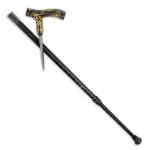

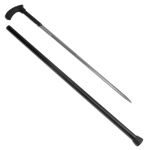
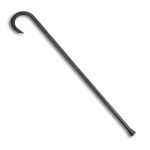


 (1)
(1)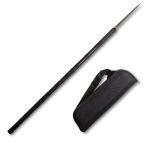
 (3)
(3)